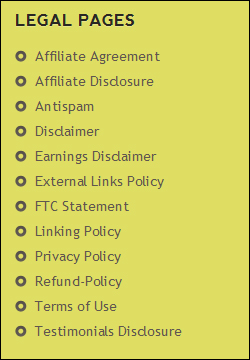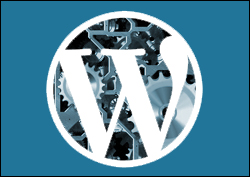
Welcome to Part Three of our Web Site Traffic Blueprint article series, where we show you how to create an automated web traffic generation machine using WordPress.
In Part One of this article series, we explained why using an expertly configured WordPress site is the key to generating automated web traffic …
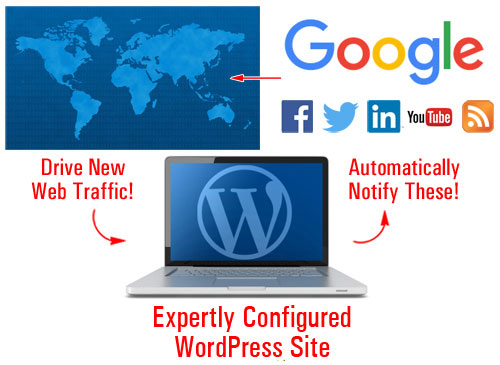
(With an expertly configured WordPress web site, all you have to do to automatically start generating more web traffic is publish fresh content consistently!)
In Part Two, we focused on the setup phase of this process. We helped you understand the best way to start if you don’t have a website yet, how to set things up if you already have a website, and what to do if your existing site was built with WordPress.
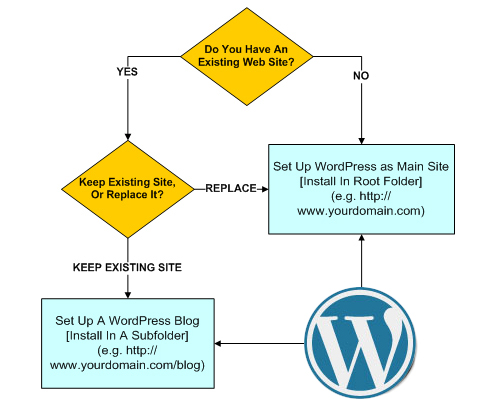
(In Part two we show you where to set up WordPress on your domain)
In this article, we discuss the configuration phase of this process. We will show you how to configure a WordPress site so you can drive new visitors automatically when you post new content to your web site.
WordPress Web Traffic Automation Blueprint – Configuration
Being able to drive more traffic to one’s website is often cited by many website owners as the greatest challenge they face online. With competition becoming increasingly more difficult businesses are looking for any advantage they believe will help them increase their competitiveness online.
The ability to generate traffic on demand is a tremendous advantage over the competition. For business owners, having an expertly configured website gives WordPress users a flying start as soon as their website is launched.
Configuration Is The Difference
There is a difference between an expertly configured WordPress site and a website that has been professionally set up by a web-building expert but not necessarily configured to its fullest advantage.
Here is a simple way to explain the differences:
With a WordPress website that has been expertly configured you get a web presence with an automated online business marketing tool!
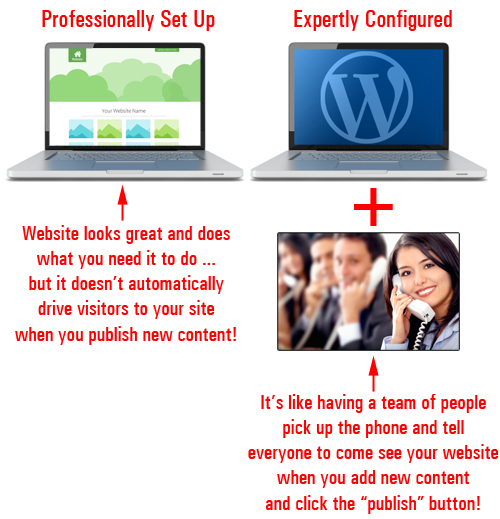
(An expertly configured site gives you a professional web presence with an automated online business marketing process!)
Not only does it take additional work to build and integrate an automated online business marketing system into your website, it also takes a special kind of expertise.
Let’s illustrate this with an amusing anecdote.
A Semi-True Story …
All is going just fine in the gizmo-making plant when things grind to a sudden halt.
As no one can figure out what’s happened, the manager decides to call in an expert.
The expert arrives within in less than an hour and, without saying a word, heads out directly to the control box. After staring silently at the box for less than 2 minutes or so, the expert then takes out a teeny-weeny hammer and makes a gentle tap near the top-right side of the box.
Immediately, everything begins to work again.
The manager is delighted as he thanks the expert, who leaves just as quickly as he had arrived.
A couple of days later, the manager receives a request of payment for services rendered totalling $5,000.
Confused and outraged, the manager rings the expert. Why did he charge them so much for so little time delivering a minimal amount of work? He promptly requests an itemized invoice and hangs up.
The next day, a bill of payment arrives in the manager’s in-tray. Upon opening the envelope, this is what he sees:
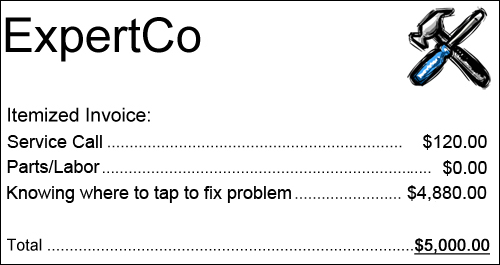
The number one challenge most businesses face online is being able to consistently drive visitors to their sites.
In the story we’ve just described, how much money did the factory stand to lose when production ground to a halt and no one on the business was able to get things up and running again? Did the expert in our story not have the right to ask to be compensated fairly for years spent developing the knowledge and expertise that enabled him to repair a very costly problem?
Similarly, if you could have a blog set up and configured so all you have to do is publish content to it and Google, Facebook, Twitter, LinkedIn, Pinterest and dozens of other web properties would be automatically notified, how much time and money would this save you?
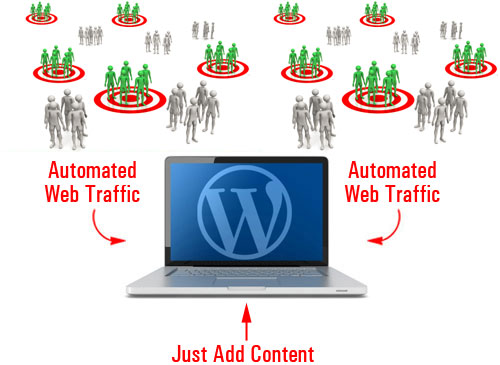
(How much time and money would you save if you could automate the process of driving traffic to your site?)
While many experts often make complex solutions look simple, it rarely is that simple or easy when you try to figure things out.
Knowing how to expertly configure a WordPress site requires more than adding some pages with content and configuring some basic settings. It involves knowing where to tap! This includes knowing things like:
- Which plugins you need to install to get various functionalities on your site.
- Which accounts you need to set up to get desired outcomes
- Which settings need to be configured to make sure things work to plan, etc.
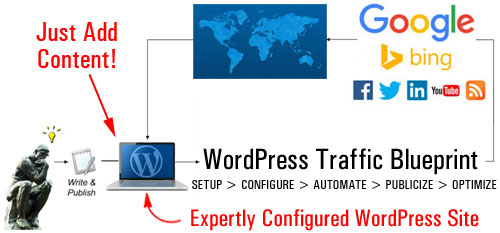
(Driving web traffic automatically with WordPress is a process that requires expertise)
Although this stage of the traffic automation system may not seem so technically challenging, it can be quite complicated. The reason why is because it’s not as easy as installing a solution, clicking on a button or two, or tweaking some options and settings in your admin area … it’s all of this and so much more.
The configuration phase is a process that involves your server, your site, and various external sites …
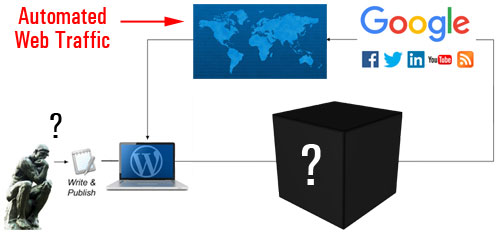
(The configuration phase involves more than just configuring a few WordPress settings)
If we were to create a simple flowchart showing the configuration process, it would look something like this …
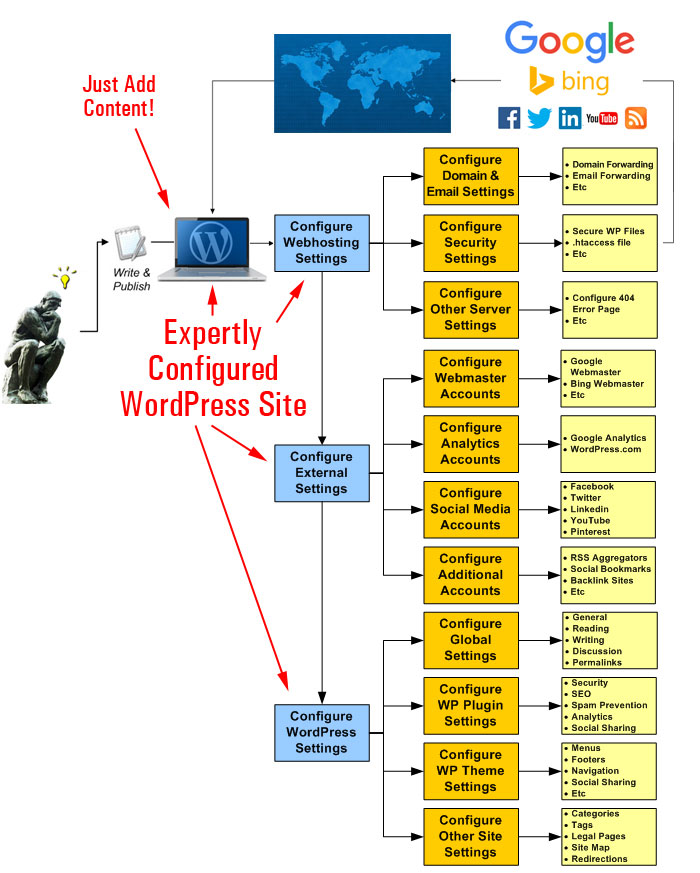
(A simplified flowchart of all the steps involved in the configuration phase)
Let’s take a look at these areas in more detail.
Your Server – Configuration
We’re not talking here about the process of configuring your web-hosting account for site installation purposes. What we are talking about, is configuring settings and options in your server specifically for handling web traffic …
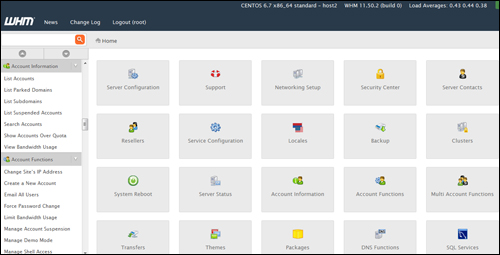
(In the configuration stage, your webhosting account settings need to be fine-tuned for handling both good and bad traffic)
Not all traffic is positive traffic. Some of the web traffic you may attract will be unwelcome traffic like spam, malicious threats, brute-force bot attacks, etc.
This stage of the configuration process, therefore, is about evaluating your needs, planning for good and unwelcome traffic and adjusting settings in your server accordingly. This includes looking at things like spam protection and security threat prevention, to configuring your domain and email forwarding, etc …
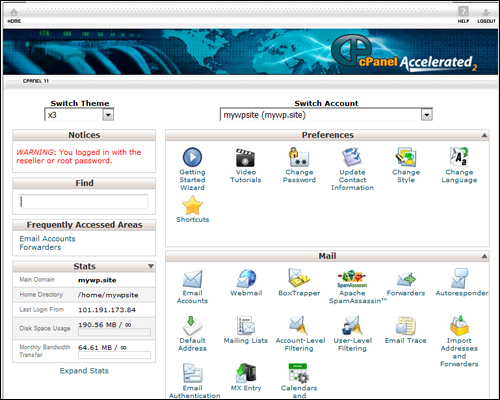
(Have you configured your hosting control panel settings for handling things like emails, page error redirects, etc?)
After fine-tuning your web server settings and configuring these (if required), the next step is to configure various external sites and online services.
External Sites
The purpose of setting up external sites is that all content will be posted to one central location (your site) and from there, it will be distributed automatically to other components of your web traffic system, or notify traffic-related web properties and services.
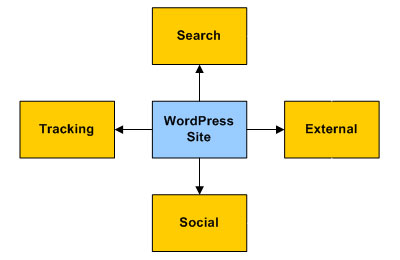
Once you add these external platforms to your traffic network, content pointing back to your website gets automatically added to these platforms. Your business will be exposed to new sources of traffic and new audiences.
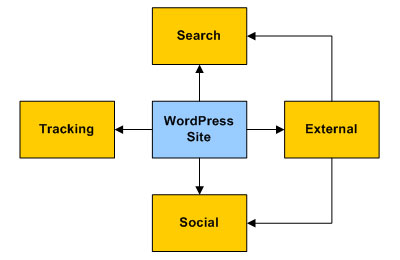
Some external sites and online services will need to be set up before configuring your site to save time and some will need to be done later, during the automation phase.
For example, you will want to set up the following accounts before configuring your WordPress site’s settings:
Google Search Console
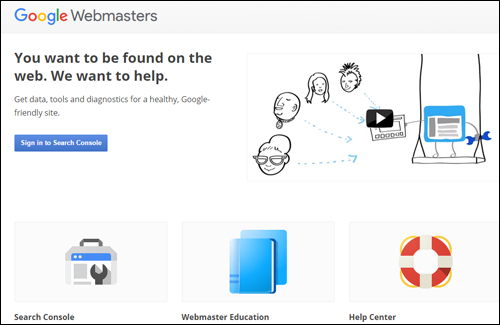
(Google Webmasters – create a Google-friendly website)
Google Search Console lets you notify Google about your site’s pages, submit XML sitemaps for automatic page indexing, and provides you with essential data, SEO tools and diagnostic reports about your website.
After setting up your account, you can use your account information to integrate and automate traffic-related settings and notifications in WordPress and other applications.
Google Analytics
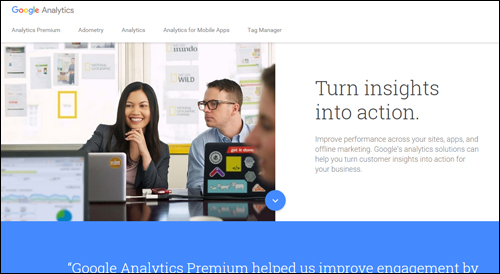
(Google Analytics)
Google Analytics lets you improve your site’s performance, SEO, marketing campaigns, sales conversions, and more, by tracking all user behaviour, pages visited, keywords searched for, social media referrals, etc.
After setting up your account and site data, traffic tracking information can be integrated with WordPress via a simple plugin used with other applications.
Bing Data And Tools
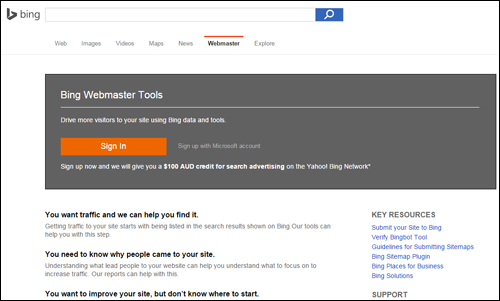
(Bing Data And Tools)
Bing Webmaster Tools is similar to Google Webmaster Tools. Once your account has been set up, this information can be used to automate traffic-related settings and notifications in WordPress (e.g. using plugins like Yoast SEO) and other applications.
WordPress.com
(WordPress.com)
As explained in Part 2, WordPress offers a self-hosted (WordPress.org) and a hosted (WordPress.com) option. We recommended choosing the self-hosted WordPress option if you plan to build a professional business presence online.
WordPress.com (the hosted option), however, provides some great tools, which various WordPress plugins can access. We recommend setting up an account with WordPress.com, therefore, and we’ll show you how to integrate this into your automated web traffic generation system in the next installment of this article series.
Social Media Sites

(Syndicate your content automatically to your social media and social bookmarking accounts and get new visitors to your site)
You will need to have already set up your various social media and social bookmarking accounts before you can integrate these with your traffic generation system.
After setting up and configuring everything, you will be able to syndicate your content automatically to your social media and social bookmarking accounts and bring new visitors to your site.
Make sure you have pages set up with all the popular social networks – Facebook, Twitter, YouTube, LinkedIn, Pinterest, etc.

There are lots of social bookmarking sites you can set up accounts with. You don’t need to go crazy, just select the ones that will work well with your system and/or content sharing tools.
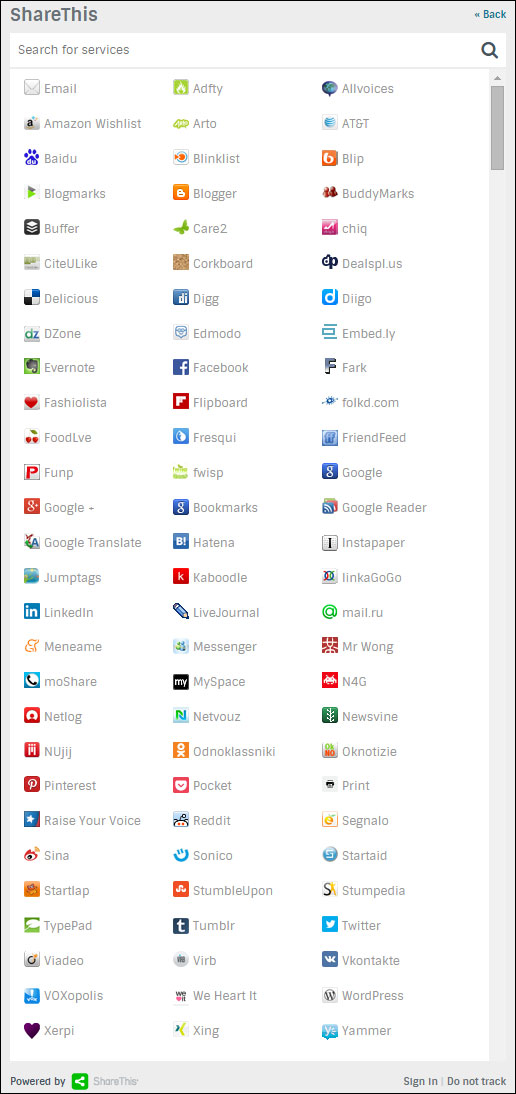
(You can post your content to lots of social bookmarking sites. Image: ShareThis.com)
Additional Sites, Aggregators, Etc.
There are many new online platforms and RSS aggregators that can act as second-tier traffic generation sources. Some are free or provide free plans, and some are paid services.
For example, here is a content aggregator that lets you add your WordPress blog feed …
RebelMouse
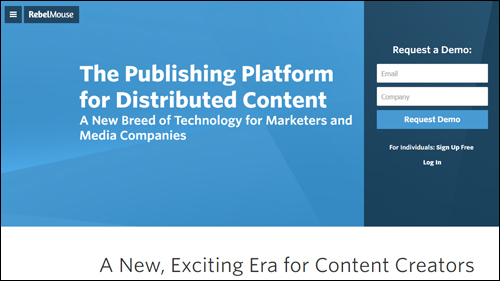
(RebelMouse – Distribute your content to social networks)
RebelMouse is a news aggregator for your RSS feeds and social profiles. Your content is displayed in a Pinterest-like format and users can follow your account.
![]()
There are many different solutions you can incorporate into your own traffic system. Please contact us if you need assistance exploring some of these further, or to discuss a strategy to suit your needs.
After you have configured your server settings and set up accounts with third-party sites, it’s time to configure your WordPress site.
WordPress Site Configuration
The first step in configuring your WordPress site for traffic is to make sure that your global settings have been correctly set up.
Let’s go over some of the important areas.
Configuring WordPress Settings
Your WordPress admin area contains a Settings menu that allows you to configure your site’s main settings …
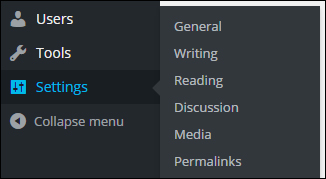
(WordPress settings section)
General Settings
Sections like Site Title and Tagline can affect your site’s SEO, search indexing, etc …
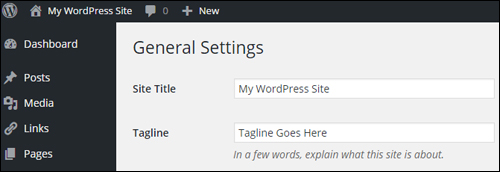
(WordPress Settings – General Settings)
Writing Settings
The Writing Settings section contains one of the most powerful and often overlooked traffic notification systems available to WordPress users …
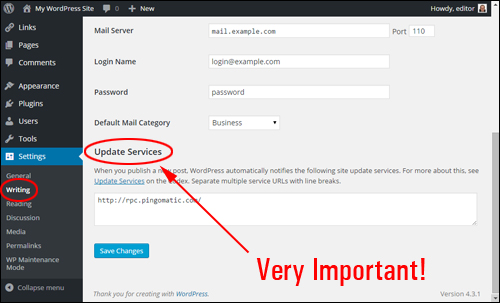
(WordPress Settings – Writing Settings)
As described in this section,
When you publish a new post, WordPress automatically notifies the following site update services …
Unless you have purposely chosen to prevent search engines from indexing your site, then your site will automatically notify the update services entered into the Update Services text area
By default, this section lists only one entry …
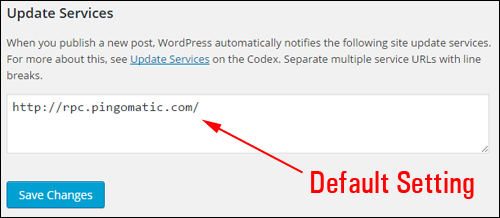
(Writing Settings – Update Services)
You can notify dozens of update services automatically with WordPress – just add a list of all the update services you want to notify as soon as you publish a new post to this section …
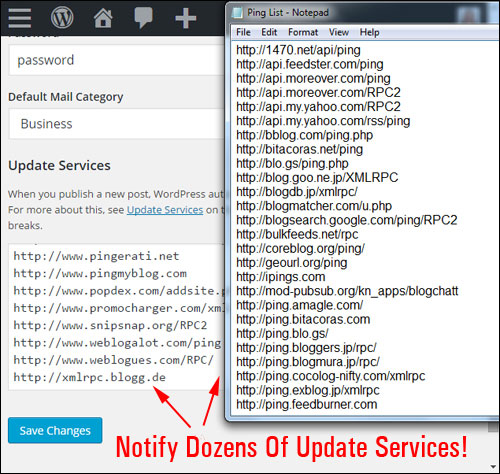
(You can notify dozens of update services automatically!)
![]()
Download A Comprehensive List Of Ping Services For Your WordPress Site!
Click the link below to download a comprehensive list of reliable and authoritative ping services for your WordPress site or blog:
Download A List Of Ping Services For Your WordPress Site
***
Note: If you need help setting up the list of ping services on your site, we recommend using a professional web services provider. You can find professional WordPress service providers in our WordPress Services Directory.
Reading Settings
This section affects how visitors will see your content when they visit your home page and blog pages.
The syndication settings in this section can influence traffic. For example, your choice to display the full content vs summaries of your post, affects how your content displays to users in RSS feeds and RSS email campaigns, and could play a part in someone’s choice to explore your content further, and whether or not they will visit your website to read the rest of the content from summaries, or read the content in full without the need to click through to your site.
The most important setting here as far as traffic is concerned is whether the Search Engine Visibility checkbox is ticked or not.
Typically, you want search engines to visit your site. Leaving this box unchecked allows WordPress to automatically notify your list of update services when a new post is published (see Writing Settings above). Unless you have a specific reason why search engines should not visit your site, leave this box unchecked …
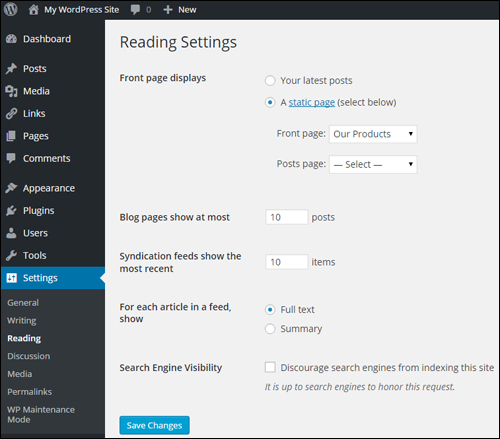
(WordPress Settings – Reading Settings)
Discussion Settings
Although discussion settings are mostly concerned with how users engage with content on your site, you have the option to allow notifications to blogs linked to from your articles, and to allow link notifications from other blogs (pingbacks and trackbacks). This can work for you, but it can also drive bad traffic in the form of SPAM comments …
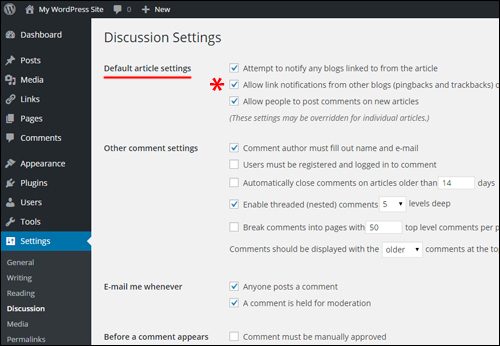
(Global Settings – Discussion Settings Screen)
Permalinks
Your Permalink settings allow you to create search engine-friendly URLs …
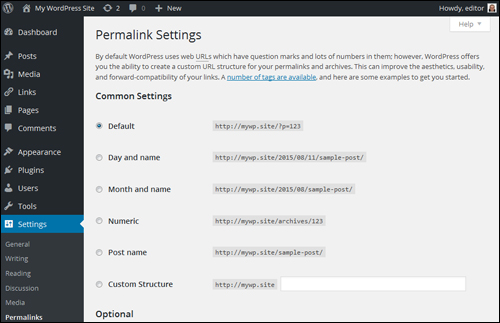
(Settings Menu – Permalink Settings)
Here are some of the ways permalink URLs can be configured …
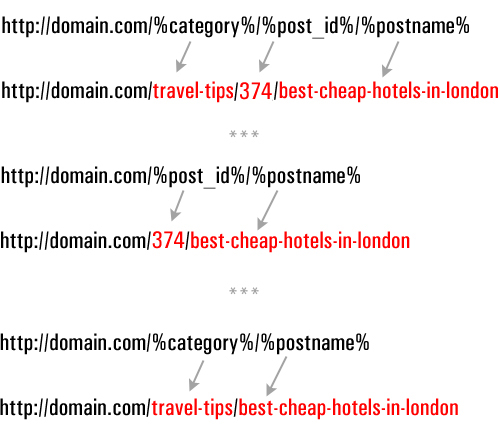
(Configuring post permalinks)
To learn more about setting up WordPress permalinks, see this tutorial: Configuring WordPress Permalinks
Configuring Settings – WP Plugins
The WordPress developer community makes available plugins that help to add almost every kind of functionality imaginable to your website, including plugins with features that help to improve traffic generation.
Let’s take a brief look at examples of plugin categories and plugins that can help to bring more visitors to your site
WordPress Security Plugins – Blog Defender
Once again, it’s important to configure your website for handling both good traffic and bad traffic. No matter what type of business you run or plan to run online and how small you think your web presence is, you simply cannot ignore the importance of securing your website or blog.
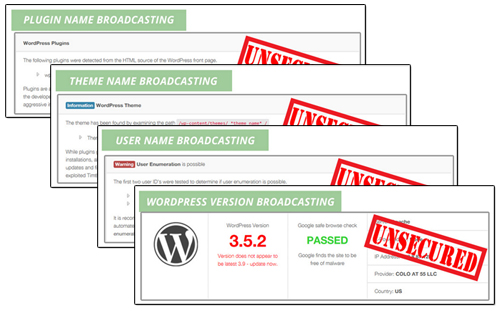 (WordPress Security Plugins stop bad traffic from harming your web presence)
(WordPress Security Plugins stop bad traffic from harming your web presence)
Security plugins like Blog Defender help to make your WordPress blog invisible to attacks from hackers and bots.
More info:
WordPress SEO Plugins – Yoast SEO
SEO plugins help drive more traffic by making your web content easily indexable …

(Yoast SEO – WordPress Plugins For SEO)
A plugin like Yoast SEO can significantly improve your website’s search engine optimization. Properly configured, this plugin not only makes your website easier for search engines like Google and Bing to find and index, it also lets you specify how your content will show up in Google’s search results and social media pages, e.g. Twitter, Facebook, and Google+.
Social Plugins
Allowing your visitors to share your content online can help drive more traffic to your site, especially if your site provides great content that adds value to readers.

(WordPress users can easily add social sharing buttons to their site using free or inexpensive plugins)
There are many social sharing plugins available for WordPress.
Most social sharing plugins let you choose which sites visitors can share your content to, embed social buttons into your content, set up custom update notifications, display/hide share counters (e.g. number of followers), etc. Some plugins even allow you to set up protected content areas on your site which users can unlock by linking or tweeting your page.
Configuring WordPress Theme Settings
As well as configuring various plugins, many WordPress themes also include features that help grow your traffic.
For example, as well as options and settings for configuring layout and design aspects of your site, some themes also give you built-in features that let you improve search optimization and site linking structure for better indexing, add analytics, social sharing buttons, etc …

(Many WordPress themes allow you to configure settings and options for better traffic results)
With many quality themes, adding social sharing features to your site is as easy as clicking a button …
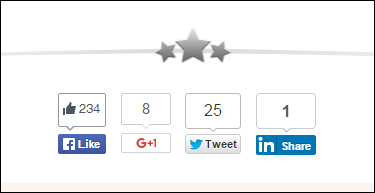
(Many WordPress themes have built-in social sharing features)
Configuring Additional WordPress Areas
Last (but by no means least) in the web traffic configuration process, are the components that need to be set up outside of the global settings.
This includes:
Website Compliance Pages
Once again, when preparing your website for an increase in visitor numbers, it’s important to plan not only for both good and unwanted traffic but also for all the situations that can seriously affect your business when more and more people find and begin to visit your website.
If you make money online (or plan to), it’s important that your site complies with regulatory agencies.
To learn more about how to quickly and easily add all necessary legal pages to your WordPress website, go here:
WordPress Post Tags & Categories
WordPress post tags & categories help to improve your site’s SEO, which helps you get more traffic.

(Post categories help search engines index your pages, which helps you get more traffic.)
As we strongly recommend in this article, it’s best to discuss and set up your site’s post tags and post categories earlier on, during the Website Planning Phases.
In the configuration phase, you will want to review and make sure that your site’s categories and tags have been set up correctly to deliver optimal results.
Add A Site Map To Your WordPress Site
A visitor site map that lists all of your site’s posts and pages is not only a useful navigation tool, it can also help external applications discover your site’s content …
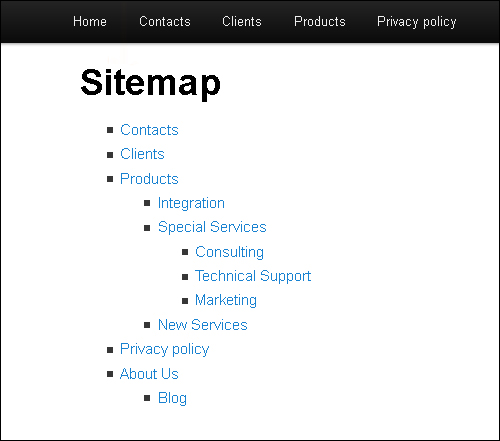
(A site map is not just great for visitors, but for web traffic too!)
![]()
An HTML site map and an XML sitemap are different things. Although search engines like Google can index your pages just using an XML sitemap (which a plugin like Yoast SEO can provide – see earlier section), allowing visitors to find more pages on your site can result in increased traffic.
404 Error Page – Don’t Forget This!
When visitors enter the wrong web address or click on an invalid hyperlink, they are greeted with a 404 Not Found page …
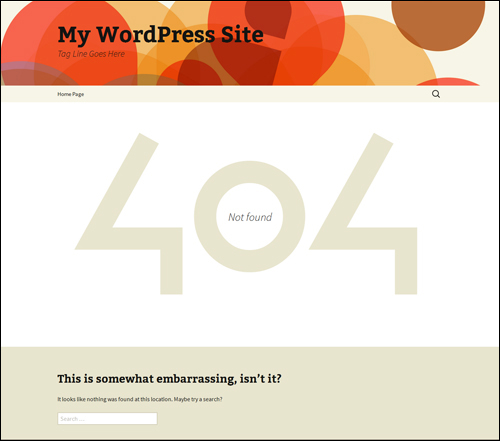
(A WordPress 404 Error Page)
Configuring your 404 page allows you to recover traffic that may otherwise be lost. …
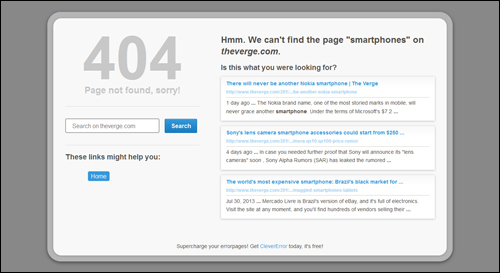
(Configuring your 404 page allows you to recover traffic that may otherwise be lost.)
![]()
Although a 404 Not Found page can be set up on your web server, there are WordPress plugins that let you easily configure your 404 page from your WordPress dashboard.
WordPress Traffic Blueprint: Configuration Stage – Summary
Once your WordPress site has been fully set up and expertly configured, all you have to do to drive more web traffic is post content consistently.
The process of expertly configuring your WordPress site, however, can be quite involved and elaborate , requiring the configuration and integration of a number of different elements and external web properties …
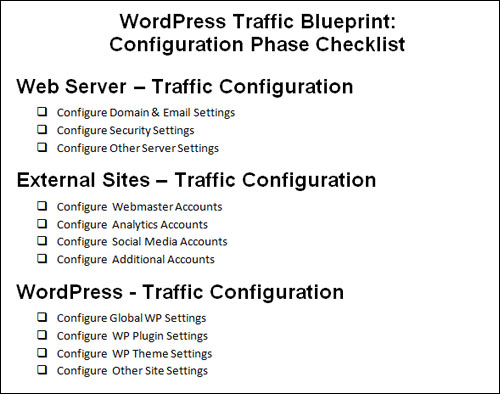
(WP Traffic System – Configuration Checklist)
![]()
The expertise involved in expertly configuring a WordPress site can take many web professionals months to learn.
Once you have expertly configured your WordPress site, the next step is to automate the aspects of the process that can be automated. This step is covered in the next article in our WordPress Traffic System series.
This is the end of Part 3
To continue reading about this topic, click here:
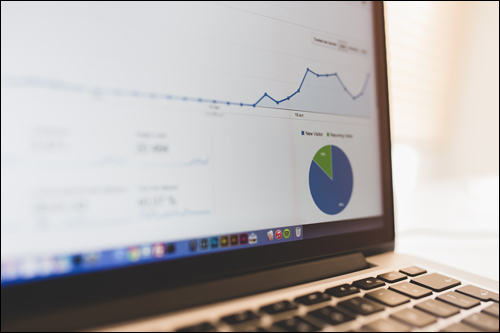
![]()
This tutorial is part of a comprehensive series of articles designed to help small business owners learn how to grow their business and drive traffic organically with a WordPress-driven website or blog and proven marketing strategies that are easy to implement.
Get Notified When New Tutorials Are Published – Subscribe Using The Form Below!
***
"This is AMAZING! I had learnt about how to use WordPress previously, but this covers absolutely everything and more!! Incredible value! Thank you!" - Monique, Warrior Forum
***


